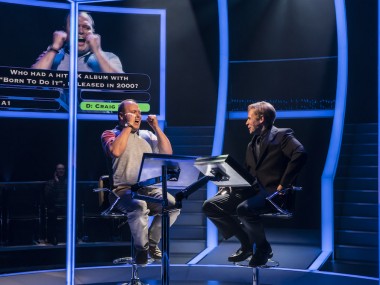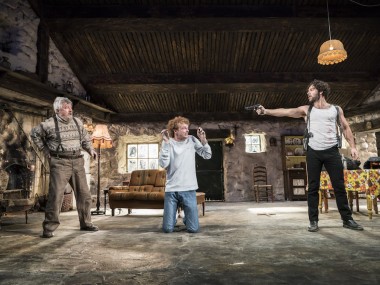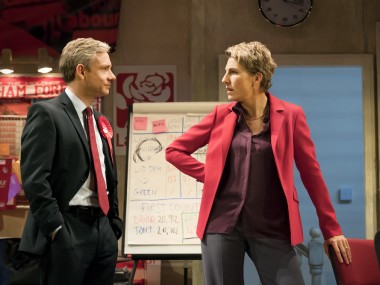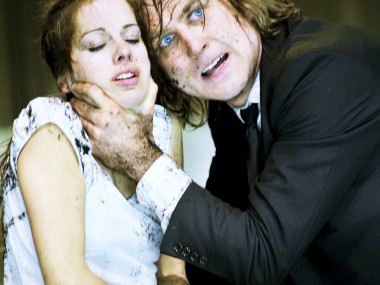The Motive and the Cue, Noël Coward Theatre
Thursday 21st December 2023
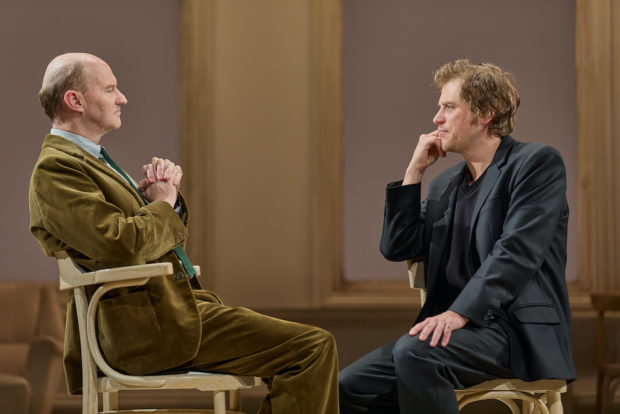
This transfer of Jack Thorne’s hit National Theatre play to the West End has been hailed as meta-theatre on steroids. After all, its St Martin’s Lane venue, which was once called the New Theatre, hosted John Gielgud’s Hamlet in 1934 for some 155 performances; now it is the stage for a play about Gielgud directing Richard Burton in the same role on Broadway in 1964, the longest running version of the Dane play there. Cue Bard on Broadway and Hamlet Homage headlines. Of course, it would have been even more meta if this was being staged at the Gielgud Theatre. As it is, it features Mark Gatiss and Johnny Flynn, and is directed by super star Sam Mendes. The play is a love letter to theatre, but does it justify the hype?
Winner of Best Play at the Evening Standard awards, the story takes place during rehearsals, and concerns the uneasy relationship between Sir John Gielgud and Dick Burton as the latter struggles to find his inner Hamlet. Burton is at the height of his fame and just married to Elizabeth Taylor, while Gielgud’s career is in the doldrums. Drawing on accounts by two of the other actors, William Redfield and Richard L Sterne, Thorne explores a generational clash between Gielgud, the old school whose acting was all about the voice beautiful, and the newcomer Burton, who values feeling and spontaneity. Between the older actor’s condescension and the younger man’s anger, the drama develops through clashes, with Burton rejecting Gielgud’s line readings and, during a drunken rage, humiliating him.
As a backstage drama The Motive and the Cue is straightforward enough, and it will not surprise anyone that the key to performing the lead role in a play about a son who has lost his father might, just might, have something to do with the lead actor’s own relationship to his father. And to his relationship with the director, a father substitute if ever there was one. When the play’s title — which comes from Hamlet’s Act Two Scene Two “rogue and peasant slave” soliloquy — is discussed the unsurprising conclusion is that great acting needs both intellect and passion. Not everything about the conflict between Gielgud and Burton is so banal, but I couldn’t fail to notice the absence of a coherent dramatic drive. What’s missing is, ironically enough, some real Burtonian passion.
While the rehearsal scenes are enlivened by a few passages from plays by “Uncle Will”, the story is padded out by the presence of Elizabeth Taylor, who in this account, is part sex kitten (in one scene literally a “fur coat and no knickers”, with some casual chat about fucking), part bored celebrity and part peace-maker between her actor hubbie and his director. Thorne is careful to make her seem more clever than Burton, less drink sozzled and more perceptive. Her breakfast meeting with Gielgud is beautifully scripted as a series of enjoyably arch exchanges. But it takes the invention of a rent boy encounter to provide room for Thorne’s Gielgud to give us a glimpse into his hidden feelings, his loneliness, his sense of old age.
Although there are some mentions of celebrity, with a nice contrast between Gielgud’s career peaking at age 25 and Taylor’s at 12 (when she appeared in the film National Velvet), this material is no more profound than what you can get any night on Netflix. A supporting cast of 15 actors play the other members of the production, but have few lines and little to do apart from cracking some weak jokes about fame and fortune. As a theatre event this feels like a rather slack docu-drama, which conjures up the lost world of the mid-1960s with a completely unchallenging and even frankly nostalgic air. It has surprising little to say about the skill of acting, or directing, and nothing at all about anything that concerns our lives today.
Mendes’s production is colourful, especially in the hotel scenes, and designer Es Devlin has created a cool beige rehearsal venue, some blue office and hotel rooms, plus a great splash of red for the Burtons’ party times. The highlight of the piece is Mark Gatiss’s Gielgud, who not only looks like Sir John, but manages to sound exactly like him. More than mimicry, however, this performance is a lovely mixture of aloofness, wit and charm, with the actor enjoying the rotund phrasing that Thorne has given him. He is able to be both sensitive and hurt. I was less impressed by Flynn, who has the unenviable task of playing Hamlet badly in the first act and then well in the second. But pretending to be a bad Shakespearean is hard to distinguish from bad acting, and his blossoming into the part feels weak and unconvincing to me. Passion? Where is it?
Neither am I much taken by the Burton–Taylor rapport. Tuppence Middleton’s acting has a kind of Mad Men vividness, but there’s no danger that the sparks between her and her husband will set the stage alight. It’s mildly funny to see her in a peach negligee and him in vest and underpants, but the search for a deeper understanding of their relationship proves, for me at least, elusive. And the same can be said of the whole production. Despite all the hype, and promise of a tempestuous drama, The Motive and the Cue never really makes you sit up, never really grabs your heart, never fully engages your mind. But does give you a sweet trip down theatre history’s memory lane.
This review first appeared on The Theatre Times

